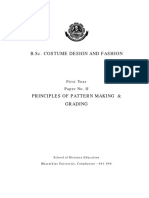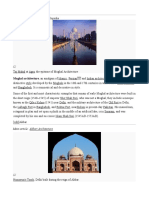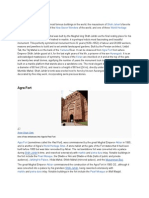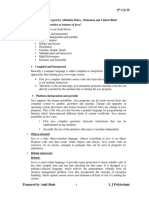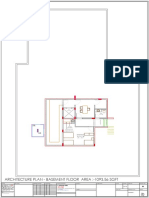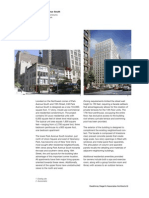0 ratings0% found this document useful (0 votes)
68 viewsBulanddarwaza
Bulanddarwaza
Uploaded by
Manpreet kaur gillThe Buland Darwaza, located in Fatehpur Sikri, India, is the highest gateway in the world. It was built in 1601 by Mughal Emperor Akbar to commemorate his victory over Gujarat. At over 53 meters tall, it took 12 years to construct and showcases a blend of Hindu and Persian architectural styles with ornate carvings and marble inlay. An inscription also highlights Akbar's religious tolerance.
Copyright:
© All Rights Reserved
Available Formats
Download as PDF, TXT or read online from Scribd
Bulanddarwaza
Bulanddarwaza
Uploaded by
Manpreet kaur gill0 ratings0% found this document useful (0 votes)
68 views9 pagesThe Buland Darwaza, located in Fatehpur Sikri, India, is the highest gateway in the world. It was built in 1601 by Mughal Emperor Akbar to commemorate his victory over Gujarat. At over 53 meters tall, it took 12 years to construct and showcases a blend of Hindu and Persian architectural styles with ornate carvings and marble inlay. An inscription also highlights Akbar's religious tolerance.
Original Title
bulanddarwaza
Copyright
© © All Rights Reserved
Available Formats
PDF, TXT or read online from Scribd
Share this document
Did you find this document useful?
Is this content inappropriate?
The Buland Darwaza, located in Fatehpur Sikri, India, is the highest gateway in the world. It was built in 1601 by Mughal Emperor Akbar to commemorate his victory over Gujarat. At over 53 meters tall, it took 12 years to construct and showcases a blend of Hindu and Persian architectural styles with ornate carvings and marble inlay. An inscription also highlights Akbar's religious tolerance.
Copyright:
© All Rights Reserved
Available Formats
Download as PDF, TXT or read online from Scribd
Download as pdf or txt
0 ratings0% found this document useful (0 votes)
68 views9 pagesBulanddarwaza
Bulanddarwaza
Uploaded by
Manpreet kaur gillThe Buland Darwaza, located in Fatehpur Sikri, India, is the highest gateway in the world. It was built in 1601 by Mughal Emperor Akbar to commemorate his victory over Gujarat. At over 53 meters tall, it took 12 years to construct and showcases a blend of Hindu and Persian architectural styles with ornate carvings and marble inlay. An inscription also highlights Akbar's religious tolerance.
Copyright:
© All Rights Reserved
Available Formats
Download as PDF, TXT or read online from Scribd
Download as pdf or txt
You are on page 1of 9
Buland Darwaza
When was it Built: 1601
Who built it: Mughal Emperor Akbar
Time taken: 12 Years
Where is it located: Fatehpur Sikri, Agra District, Uttar Pradesh, India
Why was it built: As a victory archway
Architectural Style: Mix of Hindu and Persian styles of architecture
Visit Timing: Daily, morning to evening
How to Reach: Nearest railhead is Fatehpur Sikri railway station (around 1 km) and nearest airport is Agra Airport (40
km). One can also avail UPSRTC or private bus services and cabs from Agra and neighboring regions to reach this
place.
Image Credit:
Buland Darwaza or the loft gateway at Fatehpur Sikri was built by the great Mughal emperor, Akbar in 1601. Akbar built
the Buland Darwaza to commemorate his victory over Gujarat. The Buland Darwaza, approached by 42 steps and
53.63m high and 35 meters wide, is the highest gateway in the world and an astounding example of the Mughal
architecture. It is made of red and buff sandstone, and decorated by carving and inlaying of white and black marble. An
inscription on the central face of the Buland Darwaza throws light on Akbar's religious tolerance and broad mindedness.
The Buland Darwaza towers above the courtyard of the mosque. It is semi octagonal in plan and is topped by pillars
and chhatris, echoing early Mughal design with simple ornamentation, carved verses from the Koran and towering
arches. There are thirteen smaller domed kiosks on the roof, stylized battlement and small turrets and inlay work of
white and black marble. On the outside a long flight of steps sweeps down the hill giving the gateway additional height.
A Persian inscription on eastern arch way of the Buland Darwaza records Akbar's conquest over Deccan in 1601 A.D.
Image Credit:
History, Architecture & Plan
This colossal monument that forms the main entrance of the palace at Fatehpur Sikri stands as a fine example of the
architectural brilliance of the Mughal Empire that showcases an excellent mix of Hindu and Persian styles of
architecture. Also called the ‘Gate of Magnificence’, it was added years later to the compound of Jama Masjid as a
victory arch by the Mughal Emperor, Akbar the Great in 1601 A.D. to commemorate his successful Gujarat campaign of
1573. It took around twelve years to construct this architectural wonder.
This symmetrical entrance gate with chhatris or large kiosks atop is quite high than the courtyard of the mosque and is
built with red and buff sandstones and embellished with black and white marble. There are gallery kiosks bordering the
top centre of the roof which has small minar spires and carved indentations and is inlaid with black and white marble.
The semi octagonal gateway is 15-storied high and has two three-storied wings on its two sides. Height of the
mammoth structure is around 54 meters from the pavement and can be approached by climbing 42 steps from ground
level. The top centre of the structure has three kiosks behind thirteen small domed kiosks. The gateway is surrounded
by small turrets.
Image Credit:
The main arch of the gateway with a dome atop lies in the middle of three projecting sides and is divided into three tiers
having small arches in rows as also flat brackets. The two triangular surfaces, one of the three sides of each of which
are bounded by the outer curves of the arch, are in plain red sandstone bordered with white marble and decorated with
a flower like design made of white marble. The tip of the arch is also embellished with white marble sculpted like flower.
The central arch again has three small arched openings that are outlined with ornamented panels and crowned by a
semi-dome.
The huge pillars of the structure are embellished with fine carvings apart from inscriptions comprising of quotes from
the Holy Quran and the walls are adorned with intricate designs. The towering arches, the verses from the Holy Quran
etched on it and the simple yet elegant decoration of the gateway speak volumes on early designs of the Mughal era. It
also comprises of three horizontal panels that are also found in the Badshahi Darwaza or the royal entrance that was
built as an eastern gateway leading to the Jama Masjid at Fatehpur Sikri. Among the several colossal and significant
structures of Fatehpur Sikri, Buland Darwaza remains the most towering one marking it as the highest gateway in the
world.
Image Credit:
Inscriptions on Buland Darwaza
The eastern archway of this royal gateway bears a Persian inscription that speaks of the victory of the great Mughal
Emperor Akbar over Uttar Pradesh and Gujarat. His religious tolerance is manifested from another inscription that is
etched on the gateway’s central face. It is an Islamic inscription etched in Persian language that elucidates the advice
of Jesus Christ to his followers. Another inscription comprising of verses of the Holy Quran is also found in the gateway
that was drawn by Khwaja Hussain Chishti, a disciple of the Sufi saint of the Chishti Order, Sheikh Salim Chishti. It is
carved in Naskh, a distinct calligraphic style to write in the Arabic alphabet.
Image Credit: http://djjondent.blogspot.in/2015/03/fatehpur-sikri-india.html
A Visit to the Buland Darwaza
Located at Fatehpur Sikri, one of the most popular tourist destinations near Agra, Buland Darwaza stands as a
testimony to the architectural excellence of the Mughals. As summers are scorching hot, the best time to visit this
historic city is during the winters from around November to March. The mammoth structure situated right at the entry
point of Fatehpur Sikri can be visited daily from morning to evening.
You might also like
- Principles of Pattern Making and GradingDocument162 pagesPrinciples of Pattern Making and GradingManpreet kaur gill100% (4)
- The Biography of Hazrat Salim Chisti Fatehpur SikriDocument5 pagesThe Biography of Hazrat Salim Chisti Fatehpur SikriMohammed Abdul Hafeez, B.Com., Hyderabad, IndiaNo ratings yet
- Lost Enlightenment: Central Asia's Golden Age from the Arab Conquest to TamerlaneFrom EverandLost Enlightenment: Central Asia's Golden Age from the Arab Conquest to TamerlaneRating: 4.5 out of 5 stars4.5/5 (34)
- Purves - Formal PatternsDocument27 pagesPurves - Formal PatternsEmanuele MeloniNo ratings yet
- Understanding Chiller EfficiencyDocument14 pagesUnderstanding Chiller EfficiencyOmair Farooq100% (2)
- Buland DarwazaDocument7 pagesBuland DarwazaRohan PandhareNo ratings yet
- Bengalarchitecture 151030181750 Lva1 App6891Document21 pagesBengalarchitecture 151030181750 Lva1 App6891Niriksha ShettyNo ratings yet
- Buland DarwazaDocument2 pagesBuland DarwazaShabaz AlamNo ratings yet
- Module 04 PDFDocument16 pagesModule 04 PDFIndigo CupcakeNo ratings yet
- ShahjahanDocument26 pagesShahjahanShubham DuaNo ratings yet
- History ProjectDocument11 pagesHistory ProjectShraddha ChhapoliaNo ratings yet
- Buland Darwaza Fatehpur Sikri - History, Facts, Architecture, Visit TimingDocument8 pagesBuland Darwaza Fatehpur Sikri - History, Facts, Architecture, Visit TimingSadhana SureshNo ratings yet
- Fatehpur Sikri: Emperor HumayunDocument4 pagesFatehpur Sikri: Emperor HumayunAayushDangolNo ratings yet
- Agra FortDocument35 pagesAgra Fortpankaj1617No ratings yet
- Mughal ArchitectureDocument9 pagesMughal ArchitectureRobert HowardNo ratings yet
- Mughal ArchitectureDocument9 pagesMughal ArchitectureLettisha LijuNo ratings yet
- Islamic Architecture - Provincial - ArchitecturalDocument35 pagesIslamic Architecture - Provincial - ArchitecturalSanal SamsonNo ratings yet
- Buland DarwazaDocument3 pagesBuland DarwazaTimothy BrownNo ratings yet
- Brief HistoryDocument28 pagesBrief HistorySheeren Sitara ChelladuraiNo ratings yet
- DipuDocument3 pagesDipuAnsu MishraNo ratings yet
- SST Homework: Fatehpur SikriDocument14 pagesSST Homework: Fatehpur SikriRajiv SomvanshiNo ratings yet
- Mughal Architecture: Main Article: Akbari ArchitectureDocument12 pagesMughal Architecture: Main Article: Akbari ArchitectureKarthik Subramanya100% (1)
- Mughal Monuments: Humayun's Tomb (Maqbara e Humayun) Is The Tomb of The Mughal Emperor Humayun in Delhi, India. TheDocument2 pagesMughal Monuments: Humayun's Tomb (Maqbara e Humayun) Is The Tomb of The Mughal Emperor Humayun in Delhi, India. Thehodibaaba1No ratings yet
- Fatehpur Sikri - 1Document28 pagesFatehpur Sikri - 1Ar. AsHaNo ratings yet
- Mughal ArchitectureDocument11 pagesMughal ArchitecturePrem KumarNo ratings yet
- Architecture Under AkbarDocument36 pagesArchitecture Under AkbarmaneetNo ratings yet
- Indo IslamicDocument13 pagesIndo Islamicmalligaloganathan0No ratings yet
- Indo Islamic ArchitectureDocument21 pagesIndo Islamic ArchitectureAr Srinivas PullogiNo ratings yet
- Bengal SultanteDocument26 pagesBengal SultanteRekha ojhaNo ratings yet
- Bidar Fort Deccan Architecture ..Aastha MishraDocument13 pagesBidar Fort Deccan Architecture ..Aastha MishraARVIND SAHANI100% (1)
- 2 TuglaqDocument17 pages2 TuglaqSumayya Kareem100% (3)
- Mughal Architecture Is An: Akbari SaraiDocument5 pagesMughal Architecture Is An: Akbari SaraiBISWARUP PALNo ratings yet
- Architecture Of: PakistanDocument26 pagesArchitecture Of: PakistanMuzamila BatoolNo ratings yet
- DELHI SULTANATE STYLE PPT (25 Sept)Document29 pagesDELHI SULTANATE STYLE PPT (25 Sept)RUSHALI SRIVASTAVA100% (1)
- History Project 7DDocument12 pagesHistory Project 7DSanthosh M K ShetNo ratings yet
- History ProjectDocument33 pagesHistory Projectतेजस्विनी रंजन100% (2)
- Report On Agra ND JaipurDocument12 pagesReport On Agra ND JaipurHarish NegiNo ratings yet
- Mughal ArchitectureDocument10 pagesMughal ArchitectureDeepaliGupta100% (1)
- Fatehpur SikriDocument45 pagesFatehpur SikriJinal PatelNo ratings yet
- Delhi Sultanate by Ashish and ZubairDocument28 pagesDelhi Sultanate by Ashish and ZubairRUSHALI SRIVASTAVANo ratings yet
- The Qutub ComplexDocument8 pagesThe Qutub ComplexAshhar SaleemNo ratings yet
- 6 Gujarat Provincial Indo Islamic ArchitectureDocument40 pages6 Gujarat Provincial Indo Islamic ArchitectureDakshata Koli100% (1)
- Mughal ArchitectureDocument85 pagesMughal ArchitectureJanani Surender67% (3)
- Places in AgraDocument6 pagesPlaces in Agrakarndev singhNo ratings yet
- Early Mughal ArchitectureDocument4 pagesEarly Mughal ArchitecturePøøjåNo ratings yet
- 1) Humayun's Tomb: "The Arrival of The Mughals Was A Turning Point in Indian History, More So in Its Architecture."Document4 pages1) Humayun's Tomb: "The Arrival of The Mughals Was A Turning Point in Indian History, More So in Its Architecture."Jigyasa AtreyaNo ratings yet
- Provincial Architecture BengalDocument8 pagesProvincial Architecture BengalNihal Singh Verma50% (2)
- 2 TuglaqDocument17 pages2 TuglaqMilindNo ratings yet
- 18arc5.4 Hoa V Notes Module 4Document17 pages18arc5.4 Hoa V Notes Module 4Ayan KumarNo ratings yet
- Sayyids and LodisDocument16 pagesSayyids and LodisChania BhatiaNo ratings yet
- Agra FortDocument13 pagesAgra FortSudheer Kumar YantrapalliNo ratings yet
- Tughlaq Dynasty Lodhi Dynasty: Presented By: - Piyush Goel - Kavyankit Mishra - Manvi JainDocument50 pagesTughlaq Dynasty Lodhi Dynasty: Presented By: - Piyush Goel - Kavyankit Mishra - Manvi JainAnkit LuthraNo ratings yet
- Cube and Hemisphere of The Muslim TombDocument9 pagesCube and Hemisphere of The Muslim TombMurshed Ahmed100% (1)
- Lahore FortDocument5 pagesLahore FortHashmat AlamNo ratings yet
- Tughlaq ArchitectureDocument49 pagesTughlaq Architecturemisha agarwalNo ratings yet
- Provincial Architecture of KashmirDocument5 pagesProvincial Architecture of KashmirpayalNo ratings yet
- Agra Fort: Architectural ConservationDocument26 pagesAgra Fort: Architectural ConservationRaj DarwinNo ratings yet
- Module 4 HOADocument60 pagesModule 4 HOAmalavikamm006No ratings yet
- HOA - Mughal ArchitectureDocument22 pagesHOA - Mughal ArchitectureRashmiGoyalNo ratings yet
- Module 3 SAYYID AND LODIDocument38 pagesModule 3 SAYYID AND LODIAzra Shahal100% (1)
- Deccan and BijapurDocument53 pagesDeccan and BijapurChania BhatiaNo ratings yet
- Geometric Patterns from Islamic Art and Architecture: And how to draw themFrom EverandGeometric Patterns from Islamic Art and Architecture: And how to draw themRating: 4 out of 5 stars4/5 (3)
- Basic Skirt Pattern DraftingDocument29 pagesBasic Skirt Pattern DraftingManpreet kaur gill100% (3)
- Etruscan CostumesDocument5 pagesEtruscan CostumesManpreet kaur gillNo ratings yet
- The Art Fashion Draping CompressDocument389 pagesThe Art Fashion Draping CompressManpreet kaur gill100% (1)
- Design-Objective, Rights, AsignmentsDocument20 pagesDesign-Objective, Rights, AsignmentsManpreet kaur gillNo ratings yet
- WWW - Manaresults.co - In: (Common To CE, CSE)Document2 pagesWWW - Manaresults.co - In: (Common To CE, CSE)Manpreet kaur gillNo ratings yet
- Ipr and Edp: Instructions To CandidatesDocument2 pagesIpr and Edp: Instructions To CandidatesManpreet kaur gillNo ratings yet
- Constitutional Rights Foundation: The First PatentsDocument5 pagesConstitutional Rights Foundation: The First PatentsManpreet kaur gillNo ratings yet
- Literary and Dramatic Work - A Musical Work - An Artistic WorkDocument11 pagesLiterary and Dramatic Work - A Musical Work - An Artistic WorkManpreet kaur gillNo ratings yet
- Design of Durbale Prestressed Concrete For Dabhol TrestleDocument10 pagesDesign of Durbale Prestressed Concrete For Dabhol TrestleKalipada SenNo ratings yet
- Java NotesDocument84 pagesJava NotesArka SinhaNo ratings yet
- Dinesh Ji All Floor PlanDocument4 pagesDinesh Ji All Floor PlanMUKESH VERMANo ratings yet
- Landscape Design: Topic - Villa Lante, ItalyDocument16 pagesLandscape Design: Topic - Villa Lante, ItalyShefali GoswamiNo ratings yet
- Serie HPRDocument4 pagesSerie HPREstebanRojasKrustofskyNo ratings yet
- Resume - Senior Planning Engineer (Abhinav Gupta)Document4 pagesResume - Senior Planning Engineer (Abhinav Gupta)Faaz Farooqui0% (1)
- Btech 413 Research - AlonzoDocument11 pagesBtech 413 Research - AlonzoALONZO, Vaughne Rylee S.No ratings yet
- Franc-Comtois: Model: 134 10 08Document12 pagesFranc-Comtois: Model: 134 10 08dwatkiNo ratings yet
- Lecture #1 Design of Reinforced Concrete StructuresDocument25 pagesLecture #1 Design of Reinforced Concrete StructuresKarim Ezzat100% (5)
- 05.exploded View & Part ListDocument16 pages05.exploded View & Part Listconnectingeurope8479No ratings yet
- VMAX1 and VMAX2 Hardware Fundamentals - SRGDocument82 pagesVMAX1 and VMAX2 Hardware Fundamentals - SRGsamNo ratings yet
- Linux Overview (Commands)Document9 pagesLinux Overview (Commands)fopataNo ratings yet
- 3D Model Development: SkyscrapersDocument12 pages3D Model Development: SkyscrapersRichard NashNo ratings yet
- 300+ TOP Architectural Engineering Interview Questions & AnswersDocument5 pages300+ TOP Architectural Engineering Interview Questions & AnswersIrfan AwanNo ratings yet
- Graphic Design in The Postmodern EraDocument7 pagesGraphic Design in The Postmodern EradiarysapoNo ratings yet
- 240 Park Avenue SouthDocument4 pages240 Park Avenue Southrishabh7790No ratings yet
- The English Garden 201106Document132 pagesThe English Garden 201106borotash007100% (2)
- SyserrDocument4 pagesSyserrMustafa AteşNo ratings yet
- Bungamati Nepal PDFDocument15 pagesBungamati Nepal PDFBijaya ShresthaNo ratings yet
- Cisco Nexus 7000 Series NX-OS CLI Management Best Practices GuideDocument74 pagesCisco Nexus 7000 Series NX-OS CLI Management Best Practices GuidesomeoneniceNo ratings yet
- Design of Two Way SlabDocument1 pageDesign of Two Way SlabAndro RebuyasNo ratings yet
- Data Sheet: Cello HR 290/O Cello HR 290/71Document2 pagesData Sheet: Cello HR 290/O Cello HR 290/71FWEFWEFWNo ratings yet
- Lumiere Luxuswin2 PDFDocument50 pagesLumiere Luxuswin2 PDFRodrigo Jacy Monteiro MartinsNo ratings yet
- Design of Timber Structures 3 2016Document64 pagesDesign of Timber Structures 3 2016GregorNo ratings yet
- MyPBX Standard UserManual enDocument118 pagesMyPBX Standard UserManual enAhmad_wahyuNo ratings yet
- Sabayon LinuxDocument18 pagesSabayon LinuxJacqueline Acera BalingitNo ratings yet
- Objective C MCQ Questions and AnswersDocument6 pagesObjective C MCQ Questions and Answersharsh5991No ratings yet
- Chapter 32 Javabeans and Bean EventsDocument22 pagesChapter 32 Javabeans and Bean EventsHoàng VũNo ratings yet
